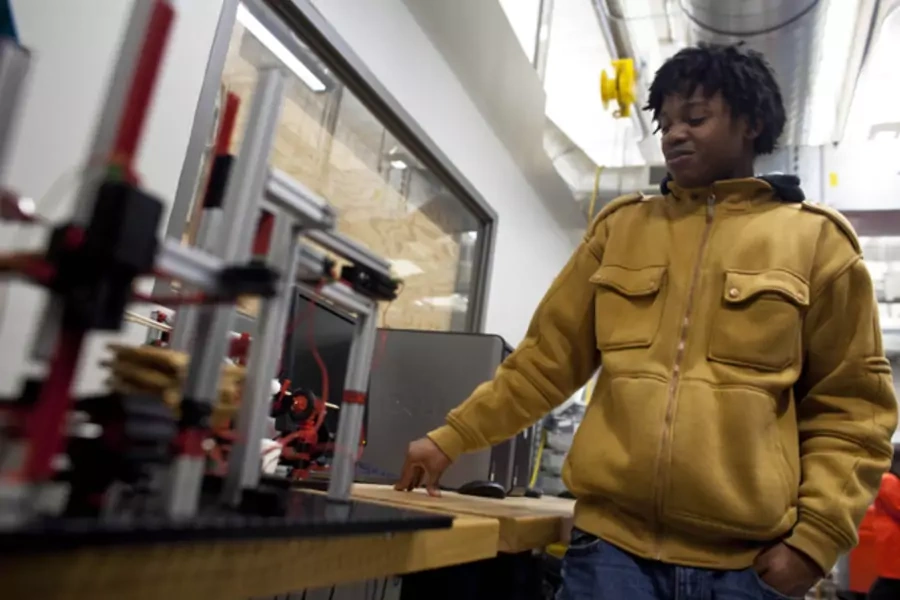How to Fill the Skills Gap: Bring Back Apprenticeships

More on:
This is a guest post by Robert Maxim, research associate, competitiveness and foreign policy, for the Council on Foreign Relations studies program.
Manufacturing is growing in the United States, but many companies claim that they face a “skills gap.” These companies have unfilled vacancies, but say that unemployed workers and recent high school graduates do not have the technical knowledge needed to fill them. Apprenticeships have historically taught students the necessary skills for a career in manufacturing. However, there has been a sharp decline in apprenticeships across the United States, some 40 percent over the past decade, and cash-strapped state budgets have forced schools to cut technical education in favor of four-year college preparatory curricula.
I recently attended a National Press Club event put on by several manufacturing industry representatives who were in town for the One Voice legislative conference, a federal government advocacy event put on by representatives of the metalworking industry. They described some encouraging initiatives that companies and communities are taking to address the problem. In Batesville, Indiana, for example, some companies have begun working with local schools to attract and train students for careers in manufacturing. Batesville Tool & Die, which makes metal stamping for vehicles and appliances, has partnered with three other local businesses to help the town’s high school students develop the skills those companies are looking for. Students take a tech-heavy high school curriculum, including technology and engineering classes in partnership with Project Lead the Way, a non-profit that develops STEM curricula for schools. In their junior and senior years, students have the opportunity to take technology classes in Indiana’s Ivy Tech Community College system, and they participate in a weekly eight hour co-op with four local manufacturing companies. At graduation, students in the program are only one semester short of an associate’s degree and have received on-the-job training, without taking on any debt. Additionally, the students have developed personal relationships with local companies that are looking to hire, and have the specific skill set that those companies are looking for.
As my colleague Rebecca Strauss has observed, in many cases there is more of a “location gap” than a “skills gap.” There may be unemployed workers who are qualified to fill a skilled position, but if they don’t live in a specific community then they may never hear about available opportunities. Programs like those in Batesville help ameliorate that problem by training local workers and placing them into the local job market. Training programs are most effective in communities with jobs available for workers to enter.
Mark Volk knows how important local industries can be to a community’s employment prospects. As president of Lackawanna College in Pennsylvania, he said he has seen the local natural gas industry take off as a result of the development of the Marcellus Shale. Volk has worked with petroleum and natural gas companies operating in the state to develop associate’s degree programs to train students in the technical and business management sides of the industry. Seventy percent of the program’s graduates are hired by major oil and gas companies, and many continue to work in their local Pennsylvania communities.
Nonetheless, establishing effective training programs may not be enough. Jody Fledderman, CEO of Batesville Tool & Die, said that many Americans now see technical school as a “second class” education, which makes parents wary and students hesitant to enroll. Ted Toth, CEO of Rosenberger-Toth, which makes parts for satellites and cell phone towers in Pennsauken, New Jersey, said the general public still perceives manufacturing as a “dark, dirty, dangerous, and dumb industry.” Both Fledderman and Toth emphasized that this perception can only be changed on the community level.
In Germany, blending technical training with secondary education is common, and many credit that model for Germany’s low level of youth unemployment and strong manufacturing base. According to the New York Times, about 60 percent of German high school students participate in an apprenticeship program. These programs can lead to a formal certification in a chosen field, and more importantly to a job at the company where the student trained. The U.S. ranks poorly among developed countries at developing “middle skills”—education beyond a high school diploma, but less than a bachelor’s degree. Although the U.S. ranks second in the share of its population with a bachelor’s degree, it ranks sixteenth in share of its population with a middle skill degree.
The United States won’t be able to improve that ranking without a serious national effort. Programs like those in Batesville and Lackawanna College can create opportunities and change attitudes in a community, but more state and federal support is needed to solve the broader skills mismatch. Manufacturing is growing in the United States again, but this growth could be limited unless more young Americans have both the skills and the desire to take on the job.
More on:
 Online Store
Online Store